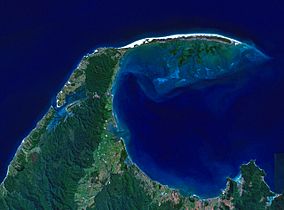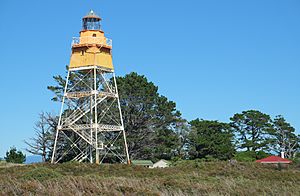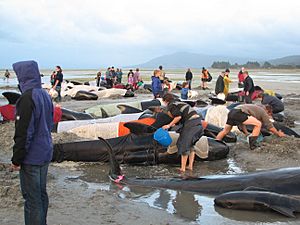Farewell Spit facts for kids
Quick facts for kids Farewell Spit |
|
|---|---|
|
IUCN Category Ia (Strict Nature Reserve)
|
|

NASA satellite image of Farewell Spit
|
|
| Lua error in Module:Location_map at line 420: attempt to index field 'wikibase' (a nil value). | |
| Location | Golden Bay, New Zealand |
| Area | 11,388 hectares (28,140 acres) |
| Designated: | 13 August 1976 |
| Reference #: | 103 |
Farewell Spit is a long, narrow sandbar located at the top of New Zealand's South Island. The Māori call it Tuhuroa. It stretches east from Cape Farewell, which is the island's northernmost point. You can find it about 50 kilometers north of Tākaka and 20 kilometers from Collingwood. The small town of Pūponga is right at its western end.
Farewell Spit forms the northern edge of Golden Bay. It is New Zealand's longest sandbar, stretching about 26 kilometers above water. Another 6 kilometers of it are hidden underwater! This amazing sandbar runs from west to east. It is made of fine golden sand, carried by ocean currents all the way from the Southern Alps.
The sand dunes on the northern side are steeper and always changing. This is because they face strong winds that blow at over 25 kilometers per hour. The southern side, which faces Golden Bay, is more stable. It is mostly covered with plants. The ocean tide here can go out as far as seven kilometers. This uncovers about 80 square kilometers of mud flats. These mud flats are a great feeding ground for many seabirds. However, they can also be a trap for whales that get stuck.
Contents
Exploring Farewell Spit's History
The first European to see Farewell Spit was Abel Tasman in 1642. He called it Sand Duining Hoeck. Later, in 1770, Captain James Cook visited. He drew Farewell Spit as a wide peninsula on his maps. He named nearby Cape Farewell. Early European settlers then called the sandbanks 'Cape Farewell Spit'. Later, the name was shortened to Farewell Spit. It was the last land Captain Cook saw when he left New Zealand for Australia.
The Farewell Spit Lighthouse
A lighthouse was built at the end of the spit. It was first lit on June 17, 1870. This was because many ships had crashed on the sandbar. The first lighthouse was made of wood. But the strong winds, sand, and salt quickly damaged it. So, in 1897, a new lighthouse was built. This one is made of steel and is the only one of its kind in New Zealand.
The spit is only about 30 meters above sea level at the lighthouse. This means the lighthouse had to be built taller than usual. The tower is 27 meters tall. Its light can be seen from 35 kilometers away! The original lamp used oil. In 1954, it was changed to a 1000-watt electric lamp. In 1966, a power cable was buried along the spit to supply electricity. The lamp was updated again in 1999 to a modern spinning light with a special bulb.
The lighthouse became fully automatic in 1984. This meant the last lighthouse keeper left. The old lighthouse keeper's house and two other buildings are still used. They are maintained by the Department of Conservation and Maritime New Zealand. Tour groups can also use them.
Protecting Wildlife and Nature
The New Zealand Department of Conservation manages Farewell Spit. It is a special reserve for seabirds and other wildlife. Most of the spit is closed to the public. You can only visit it through organized tours.
Four-wheel drive bus tours start from Collingwood or Pūponga. These tours let you jump off sand dunes and visit the lighthouse. You can also see a gannet colony. The southern side of Farewell Spit is home to thousands of seabirds. It is also a place where many whale strandings happen. Most of these are long-finned pilot whales. The northern side of the spit faces the Tasman Sea.
Shipwrecks Near Farewell Spit
Over the years, some ships have run into trouble near Farewell Spit. The ship Queen Bee got stuck off the spit in 1877. The SS Port Kembla was sunk by a mine 17 kilometers away in 1917.
The dredge Manchester was last seen near Farewell Spit in April 1912. It is believed to have sunk in the Tasman Sea between April 6 and 9. Sadly, 25 lives were lost.
Whale Strandings at Farewell Spit
Whale strandings have happened often at Farewell Spit throughout history. On November 15, 2012, a group of pilot whales got stuck on the spit. Eleven whales were found dead on the first day. Since records began, about 680 whales have become stranded here.
In January 2014, several whales got stuck and then got stuck again. This included a group of 50 pilot whales. Many of them died from stress or had to be put down, even after many tries to get them back into the water. In February 2015, more pilot whales were found stranded. On February 10, 2017, a large group of 416 pilot whales got stuck overnight. When a Project Jonah rescue team arrived, 75% of the whales were already dead. Efforts were made to help the remaining live whales get back to the ocean during high tide. Sadly, 240 more whales arrived the next day.
Images for kids
See also
 In Spanish: Farewell Spit para niños
In Spanish: Farewell Spit para niños






